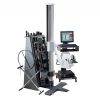
Same-day Surgery Discharge: What You Need To Know
Treatment GuidelinesMore and more patients are being discharged home after only one session with a PT or OT. Here's what you need to conduct a quick but concentrated therapy session in order to provide patients with the assessment and training they need.
Same-day discharge is quickly becoming the standard of care for elective joint-replacement surgery. More and more patients are being discharged home after only one session with a Physical or Occupational Therapist. As a therapist who recently transitioned from acute rehab to acute care, I am amazed that patients can make such a quick recovery and transition home, so soon after surgery.
I used to work with surgery patients for at least a week in a rehabilitation clinic, where patients had more time for learning, skill development, and home preparation. But in the acute care setting, I have to meet many of the same therapy goals in one, all-encompassing and highly efficient treatment session.
What patients are eligible for same-day discharge?
Before the surgery, surgeons determine whether a patient is eligible for same-day discharge. Surgeons assess the patient’s risk factors for complications, comorbidities, and their support system. For example, the surgeon takes smoking status, body mass index, narcotic use, poorly managed diabetes, access to caregivers, and limited resources into consideration.
In some cases, the patient will complete prehab before surgery. As a preventive technique, prehab strengthens the joint area and, where appropriate, trains the patient for their post-surgery restrictions. Completing prehab sessions can reduce overall recovery time and cost, decrease post-op complications, and ease patient anxiety. Sessions often involve activities for cardio, progressive resistance, flexibility, ADLs, neuromuscular electric stimulation, and more.
Despite the surgery and hospital stay lasting only a few hours, the preparation typically requires patients to participate in educational classes, have durable medical equipment ready at home, and designate caregivers – all before the day of their surgery.
Patients that are deemed appropriate for same-day discharge are closely monitored to ensure that they reach all of their post-surgical milestones. Once the patient has been medically cleared, Occupational and Physical Therapists assess the patient’s readiness for discharge, and provide recommendations for follow up care.
Assessing a patient and simultaneously providing an intervention, knowing one may likely be the only Occupational Therapist a patient interacts with during their recovery, can be overwhelming. In some hospital systems, patients go home with physical therapy services alone, meaning that their hospital stay may be their only chance to focus on activities of daily living.
It’s crucial to conduct a quick but concentrated therapy session in order to provide patients with the assessment and training they need. This will help them resume independence with self-care, light housekeeping, and health management at home. You can achieve this by focusing on a patient’s knowledge, skills, equipment, and support during their evaluation and treatment.
Focus on patient understanding in your assessment
One of the most important elements to assess is a patient’s understanding of their post-surgical precautions. Some patients are proactive and incorporate their movement restrictions into their routines before their surgery. More frequently, patients are caught off guard by the inflexibility, duration, and implications of their precautions.
Patients may have unrealistic expectations of having a caregiver help them with self-care tasks, not realizing that they will require this assistance for weeks. A patient may be able to verbalize their precautions, but may have a challenging time applying precautions to their functional activities.
Patients that stay in the hospital have the advantage of an entire team of healthcare professionals reminding them of their restrictions and providing physical assistance. However, patients at home will likely have a smaller support system and much more responsibility themselves.
Strategize to make the information stick
Pain, fatigue, anxiety, and anticipation can all contribute to poor carryover of information from the hospital to home. It’s important to do everything you can to make the information stick once the patient leaves the hospital. Here are a few ways you can increase retention in same-day discharge sessions:
- Practice occupation-based activities to make tangible connections between restrictions and capabilities.
- Identify movement restrictions, and explain which compensatory strategies and equipment can help with them.
- Get the patient dressed for home with the caregiver present. The nurses seem to really appreciate this!
- Ask for teach-back for compensatory strategies or using equipment. It’s not enough for the patient to verbalize their understanding.
- Determine additional equipment needs. The most common one I find people haven’t purchased is a sock aid. Once they see how easy it is to use, they immediately want one.
- Discuss a plan for purchasing the equipment, including what to look for, where to buy it and when they will have access to it.
- Engage the caregiver all throughout the discharge process.
Train the caregivers
One consistent theme throughout these recommendations is the importance of caregivers for a successful same-day discharge home. It would be incredibly challenging, if not impossible, for a patient to go home alone after a major surgery. At the very least, it would be dangerous.
With shorter hospital stays, patients have less room for error and a shorter learning curve. There is no guarantee that anyone will reinforce or repeat the training once a patient has gone home. This means that Occupational Therapists have to encourage the caregivers and the patient themselves to be accountable.
After you’ve ensured that caregiver comprehends the precautions, make sure that the patient or caregiver can apply the sling, brace, or splint that patient is using. Ask patients to demonstrate their home exercise programs. Provide additional training until the patient or caregiver demonstrates competency.
Caregivers provide the attentiveness and support that a patient needs during recovery in the comfort of the patient’s own home. Support caregivers by providing training and encouragement they need to assist their loved one, ensure their safety, and facilitate independence.
Show your support
If the patient has poor activity tolerance, impaired comprehension, uncontrolled pain, or a significant safety concern, it becomes essential to work with the care team to ensure home health or outpatient occupational therapy services are provided upon discharge.
Sometimes, it feels like hospitals are trying to be as judicious as possible with their resources. Therapists have to help ensure that patients aren’t falling through the cracks. This is more effective when therapists empower caregivers to advocate for their loved ones as well.
It is important to remember that despite the goal of the patient returning home on the same day of their surgery, safety always remains the most important factor in any clinical decision making. External pressure and previously established standards of care can make therapists feel hesitant, doubtful, or ineffective in their recommendations. Open communication of a patient’s functional performance and honest recommendations for continued occupational therapy services are an important part of the patient’s rehabilitation.
Putting it all together
Advancements in surgical procedures allow patients to access life-changing orthopedic surgeries, and to recover in the comfort of their own homes. By assessing patients’ knowledge of their precautions, providing training on relevant skills, and providing support via advocacy and caregiver training, Occupational Therapists play an important role in ensuring patients are prepared for a safe return home to begin their journey of healing and rehabilitation.
Corrine McGrail MS, OTR/L, CBIS




